Exploring the intricacies of Go-to-Market (GTM) strategies across diverse industries unveils a wealth of insights for businesses aiming to excel in today's competitive landscape. From Software as a Service (SaaS) to tech giants like Amazon and Apple, each entity employs unique approaches tailored to their markets. Let's dissect the strategies of SaaS, Amazon, Apple, and more, unveiling the key principles driving their success and providing a roadmap for creating effective B2B GTM strategies.
Dissecting a SaaS Go-to-Market Strategy
Developing an effective Software-as-a-Service (SaaS) Go-to-Market (GTM) Strategy can play a vital role in accelerating growth and securing a strong market position. SaaS companies operate in an incredibly dynamic and competitive environment, making a solid GTM strategy critical. We will navigate through the stages of Provocation, Discovery, Diagnostic, Design, and Recommendation in the context of a SaaS GTM strategy.
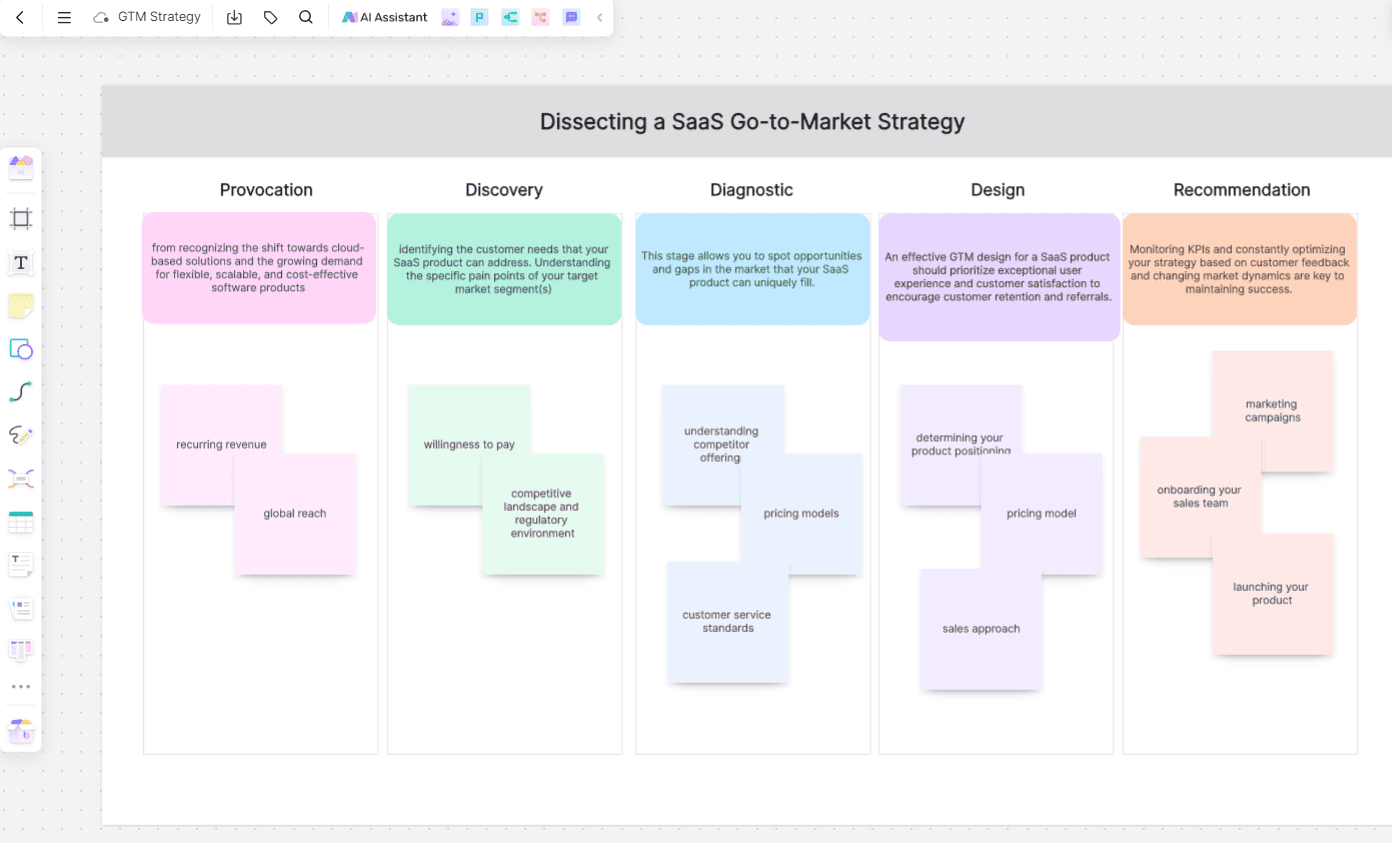
1. Provocation
The provocation for a SaaS GTM strategy often stems from recognizing the shift towards cloud-based solutions and the growing demand for flexible, scalable, and cost-effective software products. The potential for recurring revenue and global reach can also act as key provocations for starting a SaaS business.
2. Discovery
The discovery phase involves identifying the customer needs that your SaaS product can address. Understanding the specific pain points of your target market segment(s), their buying behavior and their willingness to pay is crucial at this stage. Additionally, taking into account the competitive landscape and regulatory environment is important.
3. Diagnostic
The diagnostic stage involves a comprehensive analysis of the existing SaaS market. It includes understanding competitor offerings, pricing models, customer service standards, and technological advancements. This stage allows you to spot opportunities and gaps in the market that your SaaS product can uniquely fill.
4. Design
The design stage focuses on crafting your GTM strategy. This includes determining your product positioning, pricing model, sales approach (direct sales, self-service, or a hybrid model), and marketing strategy (content marketing, PPC advertising, SEO, etc.). An effective GTM design for a SaaS product should prioritize exceptional user experience and customer satisfaction to encourage customer retention and referrals.
5. Recommendation
Upon designing your SaaS GTM strategy, it's time to put it into action. This involves deploying your marketing campaigns, onboarding your sales team, launching your product, and providing exemplary post-sales support. Monitoring KPIs and constantly optimizing your strategy based on customer feedback and changing market dynamics are key to maintaining success.
With a well-thought-out GTM strategy in place, a SaaS company can significantly improve its chances of succeeding in the competitive landscape. As always, flexibility and customer-centricity should remain at the forefront of any strategic decision-making.
Navigating an API Go-to-Market Strategy
Implementing an effective API Go-to-Market (GTM) Strategy can be pivotal in establishing your organization as a player in the software industry. APIs, or Application Programming Interfaces, allow for the interaction of different software components, and their prevalence in modern development has increased their value proposition. Let's walk through a possible GTM strategy for an API product using the five key stages - Provocation, Discovery, Diagnostic, Design, and Recommendation.
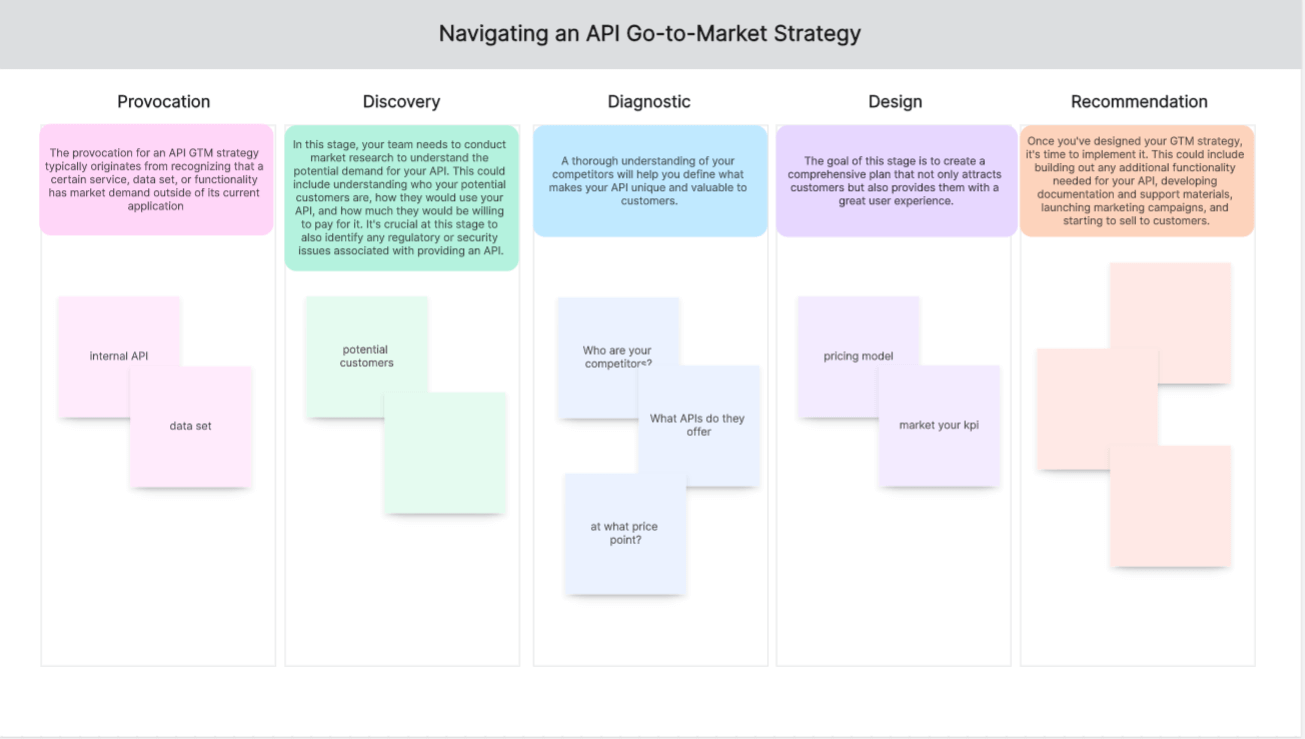
1. Provocation
The provocation for an API GTM strategy typically originates from recognizing that a certain service, data set, or functionality has market demand outside of its current application. Your company may have developed an internal API that other organizations find useful, or perhaps there's a gap in the market for a specific type of API that your company has the expertise to fill.
2. Discovery
In this stage, your team needs to conduct market research to understand the potential demand for your API. This could include understanding who your potential customers are, how they would use your API, and how much they would be willing to pay for it. It's crucial at this stage to also identify any regulatory or security issues associated with providing an API.
3. Diagnostic
Once you have a good understanding of the potential market for your API, the next stage is to diagnose the existing market dynamics. Who are your competitors? What APIs do they offer, and at what price point? How easy are they to use? A thorough understanding of your competitors will help you define what makes your API unique and valuable to customers.
4. Design
The design phase is where you outline your GTM strategy. This will include defining your pricing model (freemium, subscription-based, etc.), how you will market your API (through your channels, partnerships, etc.), and how you will support customers who are implementing your API. The goal of this stage is to create a comprehensive plan that not only attracts customers but also provides them with a great user experience.
5. Recommendation
Once you've designed your GTM strategy, it's time to implement it. This could include building out any additional functionality needed for your API, developing documentation and support materials, launching marketing campaigns, and starting to sell to customers.
Remember, no GTM strategy is perfect from the start. It will require continuous refinement based on customer feedback and changing market dynamics. By carefully working through each stage of this process, you can position your API product for success in the market.
Exploring Apple's Go-to-Market Strategy
Apple's Go-to-Market (GTM) Strategy is renowned for its effectiveness and has been instrumental in making Apple one of the most successful and influential tech companies. Let's examine how Apple's GTM strategy can be structured using the five stages - Provocation, Discovery, Diagnostic, Design, and Recommendation.
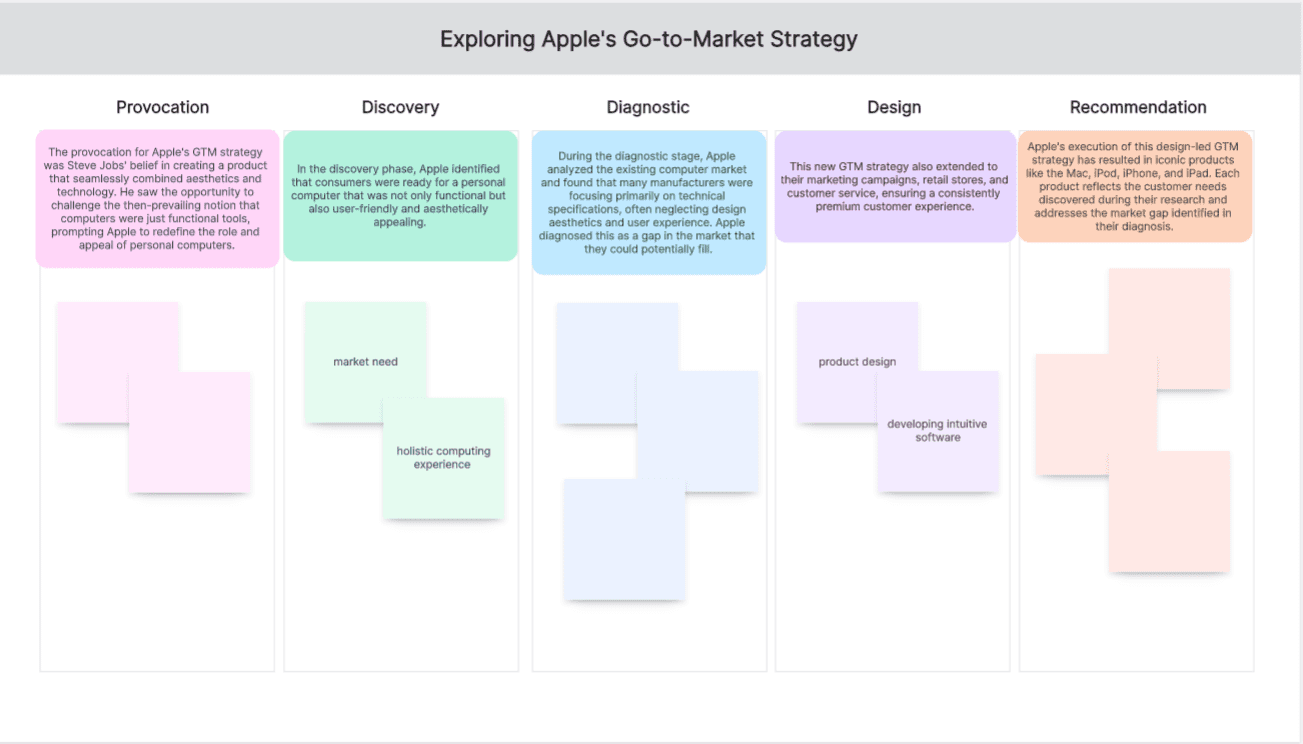
1. Provocation
The provocation for Apple's GTM strategy was Steve Jobs' belief in creating a product that seamlessly combined aesthetics and technology. He saw the opportunity to challenge the then-prevailing notion that computers were just functional tools, prompting Apple to redefine the role and appeal of personal computers.
2. Discovery
In the discovery phase, Apple identified that consumers were ready for a personal computer that was not only functional but also user-friendly and aesthetically appealing. They discovered an untapped market need for a holistic computing experience where design and ease of use were just as important as technical capabilities.
3. Diagnostic
During the diagnostic stage, Apple analyzed the existing computer market and found that many manufacturers were focusing primarily on technical specifications, often neglecting design aesthetics and user experience. Apple diagnosed this as a gap in the market that they could potentially fill.
4. Design
In response to their market diagnosis, Apple designed its GTM strategy around creating beautifully designed, easy-to-use products that didn't compromise on performance. They placed a significant emphasis on product design and invested heavily in developing intuitive software. This new GTM strategy also extended to their marketing campaigns, retail stores, and customer service, ensuring a consistently premium customer experience.
5. Recommendation
Apple's execution of this design-led GTM strategy has resulted in iconic products like the Mac, iPod, iPhone, and iPad. Each product reflects the customer needs discovered during their research and addresses the market gap identified in their diagnosis.
Apple's GTM strategy demonstrates that success lies not just in meeting customers' needs, but also in exceeding their expectations by delivering a complete experience. This commitment to providing unparalleled user experiences is what sets Apple apart in a competitive tech market.
Unfolding Amazon's Go-to-Market Strategy
Amazon's Go-to-Market (GTM) Strategy serves as an excellent case study for businesses seeking to understand how a robust GTM strategy can lead to market dominance. Although Amazon has evolved its GTM strategy over time, there are key elements that have consistently underpinned its success.
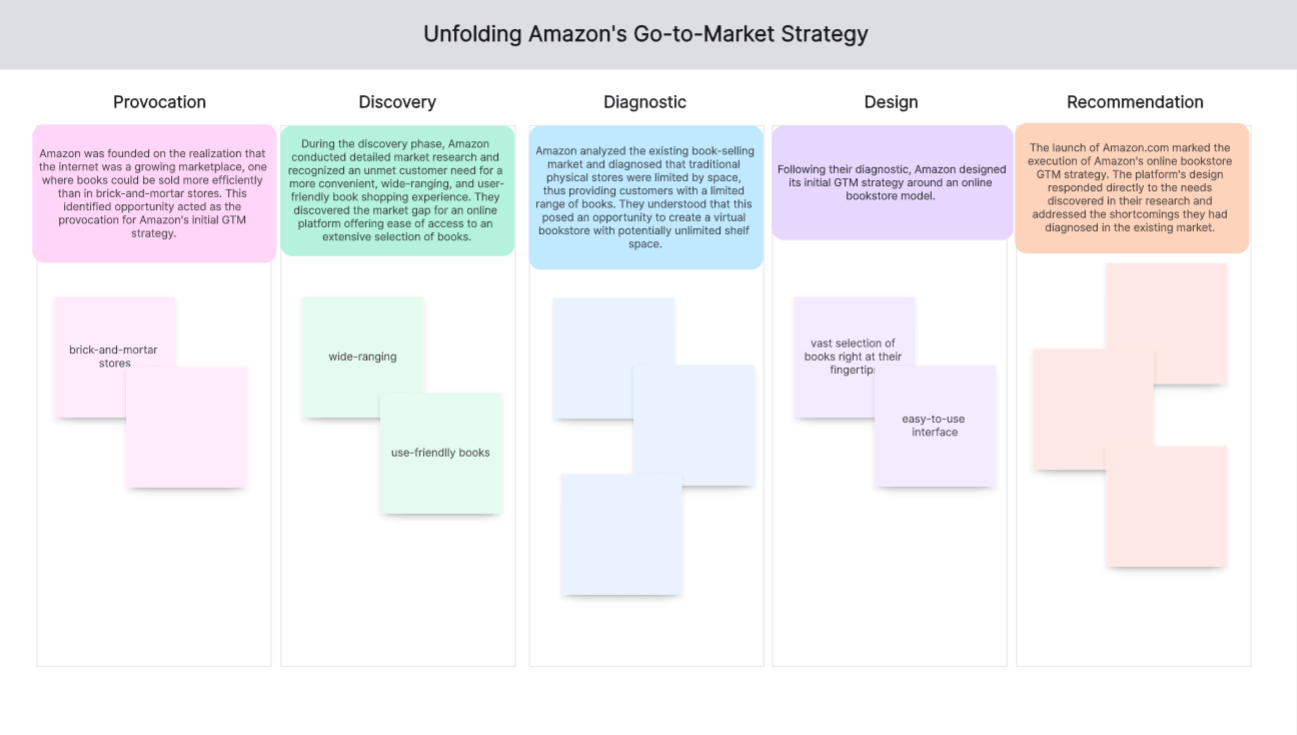
1. Provocation
Amazon was founded on the realization that the internet was a growing marketplace, one where books could be sold more efficiently than in brick-and-mortar stores. This identified opportunity acted as the provocation for Amazon's initial GTM strategy.
2. Discovery
During the discovery phase, Amazon conducted detailed market research and recognized an unmet customer need for a more convenient, wide-ranging, and user-friendly book shopping experience. They discovered the market gap for an online platform offering ease of access to an extensive selection of books.
3. Diagnostic
Amazon analyzed the existing book-selling market and diagnosed that traditional physical stores were limited by space, thus providing customers with a limited range of books. They understood that this posed an opportunity to create a virtual bookstore with potentially unlimited shelf space.
4. Design
Following their diagnostic, Amazon designed its initial GTM strategy around an online bookstore model. By leveraging the internet's capabilities, they provided customers access to a vast selection of books right at their fingertips. The design included an easy-to-use interface and an efficient delivery system to further enhance customer convenience.
5. Recommendation
The launch of Amazon.com marked the execution of Amazon's online bookstore GTM strategy. The platform's design responded directly to the needs discovered in their research and addressed the shortcomings they had diagnosed in the existing market. This strategy was successful, and Amazon soon became the go-to online platform for buying books.
Since then, Amazon has continuously iterated its GTM strategy, using similar principles to expand into different product categories, enter new markets, and innovate with offerings like Amazon Prime and AWS. Amazon's ability to continuously redefine its GTM strategy in line with market changes and customer needs is one of the core reasons for its enduring success.
Understanding AWS's Go-to-Market Strategy
Amazon Web Services (AWS) is a leading provider of cloud computing services, and its robust Go-to-Market (GTM) strategy plays a significant role in its ongoing success. Below, we take a closer look at AWS's GTM strategy through the five stages - Provocation, Discovery, Diagnostic, Design, and Recommendation.
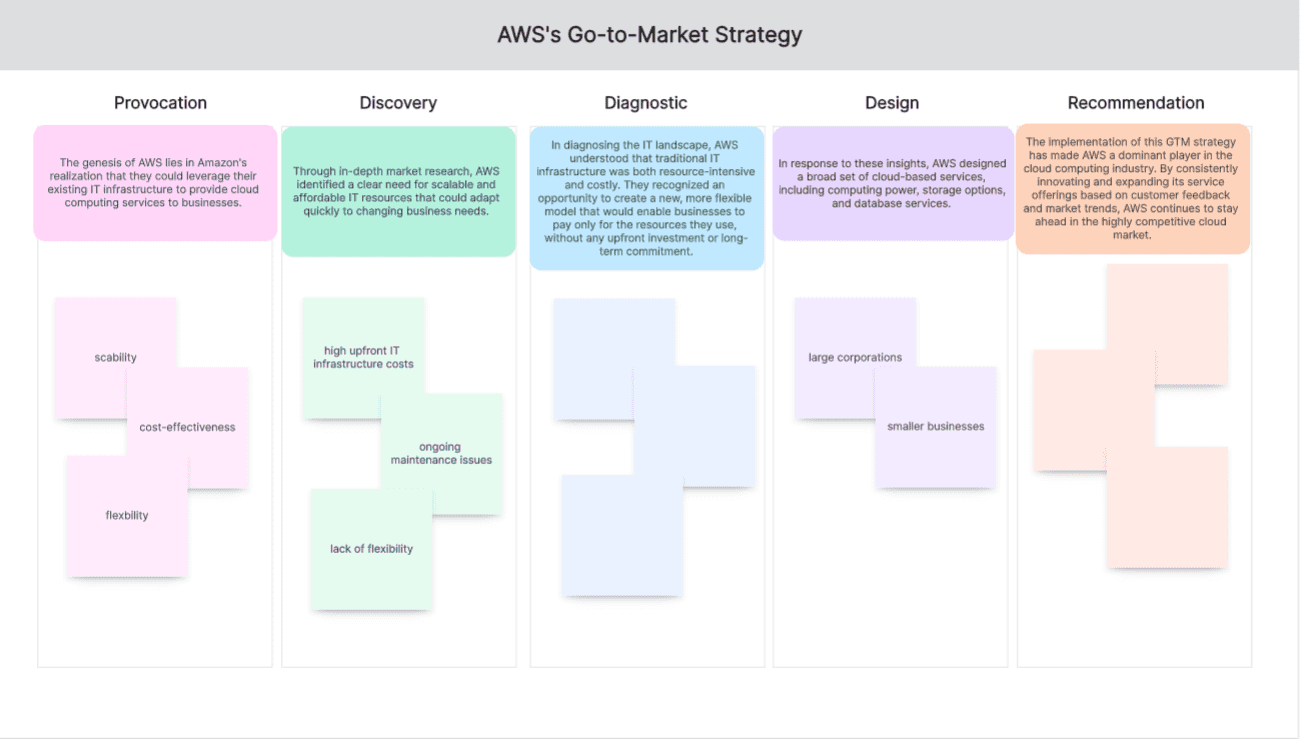
1. Provocation
The genesis of AWS lies in Amazon's realization that they could leverage their existing IT infrastructure to provide cloud computing services to businesses. The scalability, cost-effectiveness, and flexibility offered by cloud services were seen as key provocations for this new venture.
2. Discovery
Through in-depth market research, AWS identified a clear need for scalable and affordable IT resources that could adapt quickly to changing business needs. Many companies were struggling with high upfront IT infrastructure costs, ongoing maintenance issues, and a lack of flexibility.
3. Diagnostic
In diagnosing the IT landscape, AWS understood that traditional IT infrastructure was both resource-intensive and costly. They recognized an opportunity to create a new, more flexible model that would enable businesses to pay only for the resources they use, without any upfront investment or long-term commitment.
4. Design
In response to these insights, AWS designed a broad set of cloud-based services, including computing power, storage options, and database services. Their GTM strategy focused on serving both large corporations and smaller businesses by providing the tools and resources necessary to scale quickly and manage applications effectively. They positioned AWS as a one-stop-shop for all cloud computing needs.
5. Recommendation
The implementation of this GTM strategy has made AWS a dominant player in the cloud computing industry. By consistently innovating and expanding its service offerings based on customer feedback and market trends, AWS continues to stay ahead in the highly competitive cloud market.
From its inception, AWS has focused on customer-centricity, innovation, and long-term thinking - principles that are ingrained in Amazon's DNA. This approach has enabled them to effectively cater to evolving customer needs and establish a strong foothold in the global cloud market.
How to Create a Robust B2B Go-to-Market Strategy
Developing an effective B2B Go-to-Market Strategy is fundamental for companies aiming to sell their products or services to other businesses. The strategy will vary depending on the nature of your offering, target audience, and market dynamics. However, there are key elements common to all successful B2B GTM strategies.
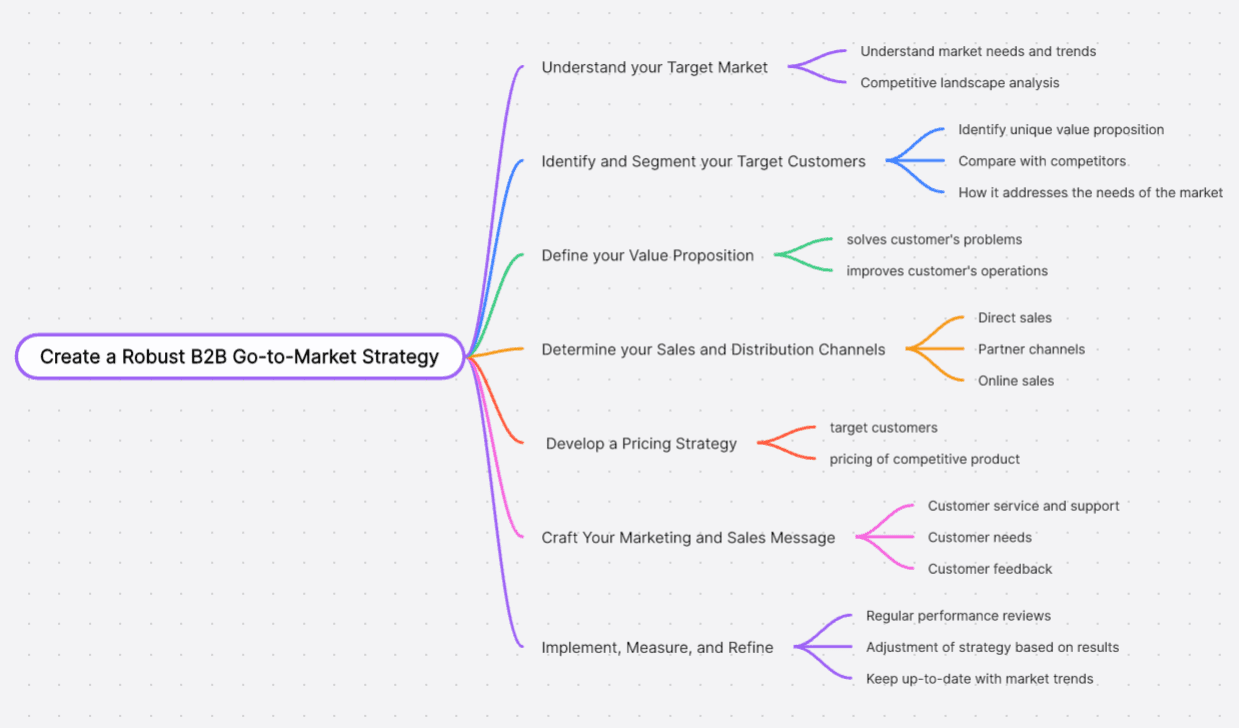
1. Understand your Target Market
Start by understanding the market in which you plan to sell your product or service. Evaluate the size of the market, its growth potential, key trends, competitive landscape, and regulatory environment. This market knowledge will form the foundation of your GTM strategy.
2. Identify and Segment your Target Customers
Not all customers in your target market will have the same needs and characteristics. Thus, it's crucial to segment your customers based on factors like business size, industry, geographic location, buying behavior, etc. Once segmented, you can create detailed buyer personas for each group to better understand their specific needs and preferences.
3. Define your Value Proposition
Clearly articulate why businesses should buy your product or service over those offered by competitors. This should be more than just the features of your product; it should encompass the entire value your solution provides to customers, including how it solves their problems, improves their operations, or impacts their bottom line.
4. Determine your Sales and Distribution Channels
Decide how you will sell and deliver your product or service to your customers. Options could include direct sales (where you sell directly to customers), inside sales (selling remotely through calls or emails), channel sales (using distributors or partners), or a hybrid model.
5. Develop a Pricing Strategy
Your pricing strategy should reflect the value your solution delivers, the price sensitivity of your target customers, and the pricing of competitive products in the market. In B2B sales, where larger transactions are common, having flexible pricing options (like volume-based discounts or tiered pricing) can be an effective strategy.
6. Craft Your Marketing and Sales Message
The way you communicate about your product or service should resonate with your target customers and convince them to take action. Use the buyer personas you created to tailor your messaging to address their specific needs and show how your solution meets these needs.
7. Implement, Measure, and Refine
Finally, roll out your GTM strategy, measure its effectiveness against set objectives, and continually refine it based on feedback and changing market conditions.
In conclusion, a robust B2B GTM strategy requires thorough research, careful planning, and continuous optimization. It's not a one-size-fits-all process but a dynamic strategy that evolves with changing business environments and customer needs.
Conclusion
In conclusion, dissecting the GTM strategies of SaaS, Amazon, Apple, and others underscores the diversity of approaches tailored to specific markets and industries. By understanding the key principles driving their success, businesses can craft robust B2B GTM strategies aligned with their objectives and market dynamics. This exploration serves as a valuable roadmap for navigating the complexities of modern markets and achieving sustainable growth.









